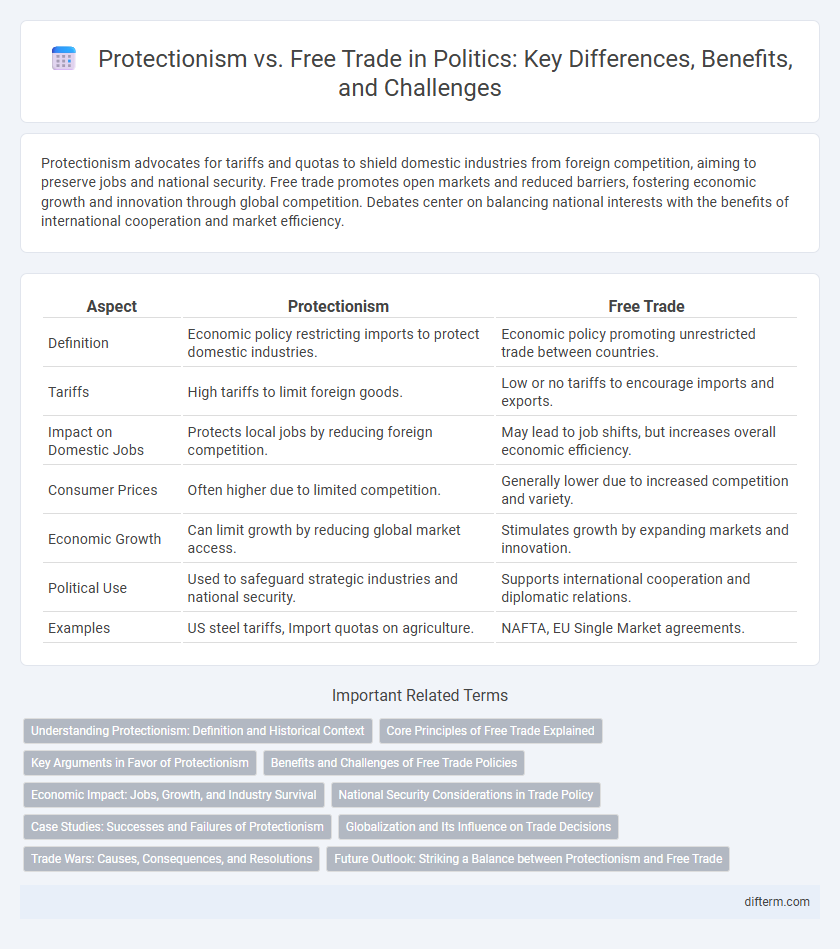Protectionism advocates for tariffs and quotas to shield domestic industries from foreign competition, aiming to preserve jobs and national security. Free trade promotes open markets and reduced barriers, fostering economic growth and innovation through global competition. Debates center on balancing national interests with the benefits of international cooperation and market efficiency.
Table of Comparison
| Aspect | Protectionism | Free Trade |
|---|---|---|
| Definition | Economic policy restricting imports to protect domestic industries. | Economic policy promoting unrestricted trade between countries. |
| Tariffs | High tariffs to limit foreign goods. | Low or no tariffs to encourage imports and exports. |
| Impact on Domestic Jobs | Protects local jobs by reducing foreign competition. | May lead to job shifts, but increases overall economic efficiency. |
| Consumer Prices | Often higher due to limited competition. | Generally lower due to increased competition and variety. |
| Economic Growth | Can limit growth by reducing global market access. | Stimulates growth by expanding markets and innovation. |
| Political Use | Used to safeguard strategic industries and national security. | Supports international cooperation and diplomatic relations. |
| Examples | US steel tariffs, Import quotas on agriculture. | NAFTA, EU Single Market agreements. |
Understanding Protectionism: Definition and Historical Context
Protectionism refers to government policies that restrict international trade to shield domestic industries from foreign competition, often through tariffs, quotas, and subsidies. Historically, protectionist measures have surged during economic downturns, such as the Smoot-Hawley Tariff Act of 1930, which intensified the Great Depression by triggering retaliatory trade barriers. This approach contrasts with free trade policies that promote open markets and aim to enhance economic efficiency through comparative advantage.
Core Principles of Free Trade Explained
Free trade is grounded in the principle of comparative advantage, where countries specialize in producing goods they can create most efficiently, leading to increased global economic welfare. It promotes the removal of tariffs, quotas, and other barriers to encourage open markets and stimulate competition. These core principles aim to enhance consumer choice, reduce costs, and foster innovation by allowing the unrestricted flow of goods and services across borders.
Key Arguments in Favor of Protectionism
Protectionism supports safeguarding domestic industries through tariffs and quotas to prevent job losses caused by foreign competition and to maintain national economic security. Advocates argue that protecting emerging industries fosters innovation and long-term competitiveness by allowing them time to grow without being overwhelmed by established global players. Furthermore, protectionist policies can reduce dependency on foreign goods, ensuring stability in critical sectors during economic or geopolitical uncertainties.
Benefits and Challenges of Free Trade Policies
Free trade policies stimulate economic growth by increasing market access and promoting competition, leading to lower consumer prices and innovation. However, they can also result in job displacement and income inequality as industries adjust to global competition. Governments must balance these benefits with social safety nets and targeted support to mitigate adverse effects on vulnerable sectors.
Economic Impact: Jobs, Growth, and Industry Survival
Protectionism can safeguard domestic industries and preserve jobs by limiting foreign competition, but often leads to higher consumer prices and reduced economic growth. Free trade promotes efficiency, innovation, and broader market access, which drives GDP growth and job creation in competitive sectors. However, it may cause job displacement and industry decline in less competitive industries, necessitating targeted adjustment policies.
National Security Considerations in Trade Policy
National security considerations play a crucial role in shaping trade policy, often motivating protectionist measures to safeguard critical industries and technology from foreign dependence. Governments implement tariffs, quotas, and export controls on strategic sectors such as defense, telecommunications, and energy to prevent potential vulnerabilities. Balancing economic efficiency with national security priorities remains a central challenge in the debate between protectionism and free trade.
Case Studies: Successes and Failures of Protectionism
The success of protectionism is evident in South Korea's rapid industrialization during the late 20th century, where tariffs and import restrictions nurtured domestic manufacturing sectors. In contrast, Argentina's prolonged reliance on protectionist policies led to economic stagnation and reduced competitiveness in global markets. These case studies illustrate that protectionism's efficacy depends on factors such as government efficiency, market size, and the ability to innovate domestically.
Globalization and Its Influence on Trade Decisions
Protectionism and free trade represent two contrasting approaches to globalization influencing trade decisions worldwide. Protectionist policies aim to shield domestic industries through tariffs and quotas, slowing globalization's integration effects but prompting trade disputes. Free trade promotes global economic interdependence by reducing barriers, fostering innovation and efficiency, while exposing markets to global competition and economic fluctuations.
Trade Wars: Causes, Consequences, and Resolutions
Trade wars arise from protectionist policies aimed at shielding domestic industries through tariffs and quotas, often leading to retaliatory measures that escalate economic conflict. Consequences include disrupted global supply chains, increased consumer prices, and slowed economic growth, impacting both exporting and importing nations. Resolutions typically involve multilateral negotiations, trade agreements, and dispute resolution mechanisms under international bodies like the World Trade Organization to restore open trade and economic stability.
Future Outlook: Striking a Balance between Protectionism and Free Trade
Emerging global economic trends indicate a nuanced approach where nations gradually blend protectionist policies with free trade principles to safeguard industries while promoting innovation and market access. Technological advancements and geopolitical shifts drive this hybrid strategy, aiming to enhance domestic competitiveness without sacrificing international cooperation. Policymakers increasingly prioritize sustainable growth, digital trade facilitation, and strategic autonomy to maintain economic resilience in a dynamic global market.
Protectionism vs Free trade Infographic

 difterm.com
difterm.com